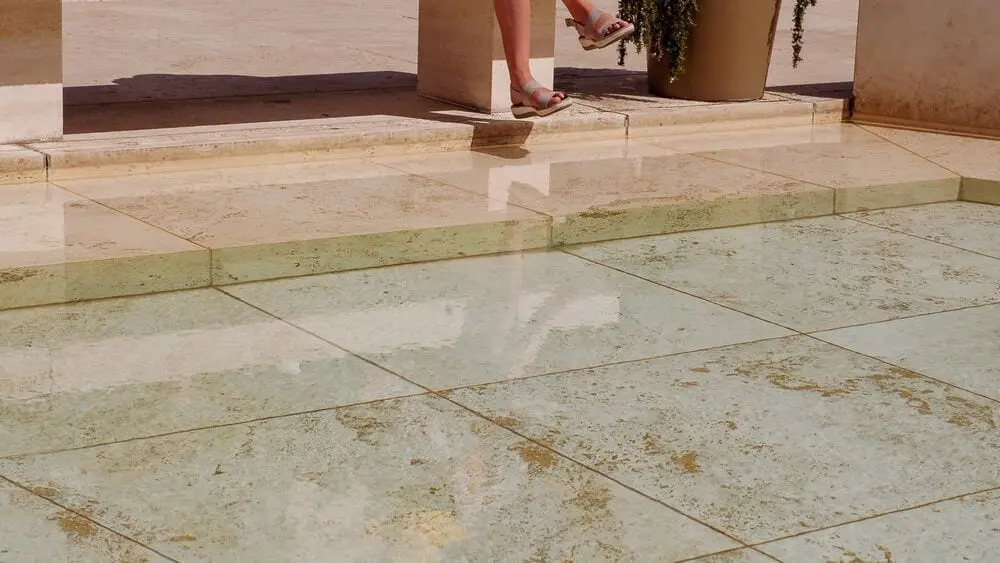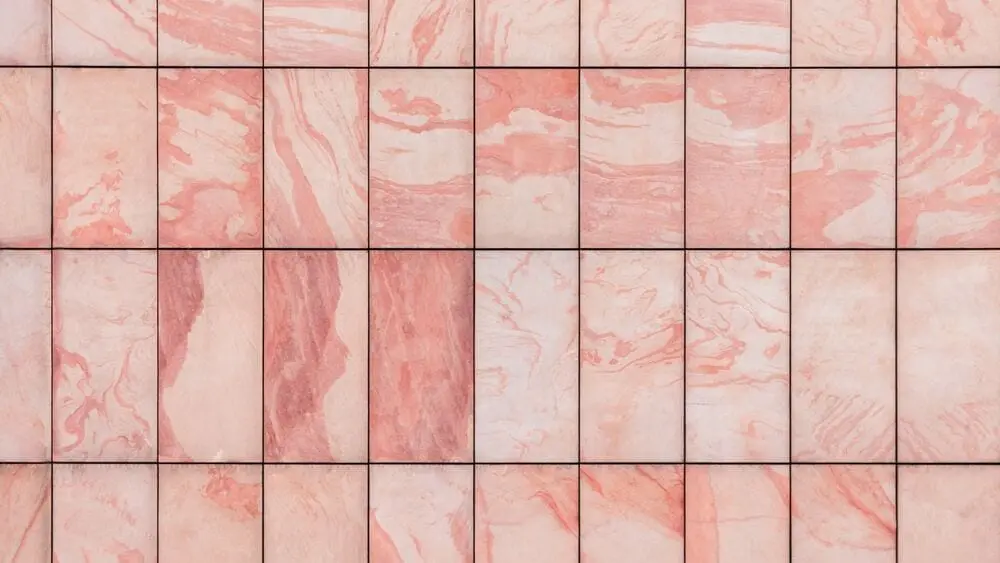
While exploring Coverings 2019, I couldn’t help but notice all the huge slabs of porcelain featured in many of the booths. They were used everywhere: walls, floors, counters, indoors, outdoors. There are several very good reasons why this material is trending big time and growing in popularity. Let’s take a look at the benefits that large-format porcelain offers and why homeowners are increasingly choosing it over marble and other natural stone materials.
What Are Large-Format Porcelain Slabs?
You probably already have porcelain in your home. Many kinds of dinnerware, vases, floor tiles, sinks and toilets are made from porcelain. For centuries, it has been appreciated as a beautiful, strong and durable material, and the individuals and companies working with the material are continuing to find new uses for it.
Originating in Europe and finally jumping across the pond to American homes, porcelain slabs are like porcelain tiles, but much, much bigger. They are often available in sizes of up to 10-by-5 feet, and can be custom-ordered in even larger sizes. Because they are only 6 to 12 mm thick, they are easy to work with and lightweight. Peter Pental of Pental Surfaces notes, “Most tile on the market today is good quality, so it’s really the format that sets one tile apart from another. Large-format thin tiles can be used as either slab or tile and are ideal for flooring since it allows for the look without the thickness issues that came with using stone slab on the floor.”
These slabs are s-t-u-n-n-i-n-g! They really make a statement and can be used in ways that marble and other natural stones cannot. They are not made by artisans, but in very impressive, high-tech facilities where much of the process is automated and handled by machines and robots.
The Benefits of Large Format Porcelain Slabs
1. May Save You Money
Porcelain slabs cost $8 to $15 dollars per square foot, which may cost less than comparable materials.
2. Fewer Joints and Seams
Ideal for a virtually seamless look that is very luxurious.
3. Uses Less Grout
This means less mess during installation, but it also means the end result is more visually appealing.
4. Easy to Install
Only an adhesive is needed for install, followed by a cement or epoxy grout for seams. However, installation is not suitable as a DIY project and should be done by professionals.
5. Easy to Maintain
Porcelain is easy to clean and difficult to damage. There is no ongoing maintenance necessary to maintain the beauty of porcelain slabs.
6. Heat-Resistant
Because porcelain is fired at such high temperatures, any temperature it will experience in your home is much lower, making it ideal for countertops.
7. Does Not Stain
Because porcelain is denser and less porous than other materials, it is ideal for any residential application.
8. Does Not Get Scratched or Worn
Durability is important for both residential and commercial applications, so the strength of porcelain is a great benefit.
9. Can Be Installed on Existing Surfaces
Large-format porcelain can be installed right over current flooring or counters, making it a great option for home renovations.
10. Unlimited Variety of Surface Designs
Sky’s the limit! Solid colors, floral designs, geometric patterns, stone-look, wood-look, concrete-look and more.
11. So Many Applications
In the home, applications include walls, floors, backsplashes, countertops, sinks, tubs, showers, fireplace surrounds, furniture, exterior cladding, pools, patios and more.
How Porcelain Slabs Compare to Marble Slabs

Since porcelain slabs are much thinner than marble slabs, they are lighter and easier to transport and handle during installation. “Installers love it,” comments Ken Davis of Davis Stone. “It’s easy to cut and easy to install, if you know what you’re doing.” Because marble slabs are so thick — up to 3 inches — the process for installing them is much more labor intensive. In addition to marble’s thickness, the deck mud layer underneath the slab needs to be 2 to 3 inches thick. Every layer needs a special treatment to prepare it for the next layer, so the entire process is more involved than installing large-format porcelain. Installing marble slabs on top of current flooring isn’t even an option.
As noted above, porcelain is much less likely to absorb stains than the more porous natural stone because porcelain is fired at such high temperatures. The result is that porcelain is stronger than granite and marble and matches the hardness of quartz. There’s no need to apply a protective sealant to porcelain, and it is not vulnerable to water or sunlight, unlike natural stone.
If cost is a concern, choosing porcelain could save you money. For installation and materials, porcelain slabs cost $8 to $15 dollars per square foot, while marble ranges from $9 to $24. So you can get higher-end porcelain slabs for considerably less than the cost of higher-end marble. Both large-format porcelain and marble add value to your home, with marble being a classic and timeless option and porcelain being the new, cool kid on the block. When it comes to home value, both are good options, but for different reasons. But when you weigh porcelain’s wide variety of applications, designs, easy maintenance and other benefits listed above, it’s the clear overall winner.

For the last 16 years, Rachel Kinbar has been a writer of articles, blog posts, white papers, essays, infographics, web copy, sales copy, scripts, poetry, lyrics, and more. She has keen research skills that she applies to a wide variety of topics, and she especially loves topics related to design, history, and sustainable living.
 Life as Design: Planning Awesome Fish Tanks in New Homes
Life as Design: Planning Awesome Fish Tanks in New Homes
David Roach
I am interested in a porcelain slab 5’x5′. Is this size possible to obtain?
Jamie Garcia
Hi David,
It should be possible to find a slab this size.
Dj Parker
Where do you purchase the 10’x5′ slabs
Jamie Garcia
Hi DJ,
Contact your local home improvement store or tile specialty store to see if they have the size slabs you’re looking for.